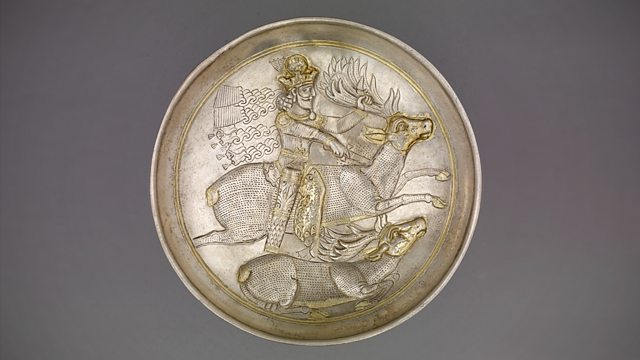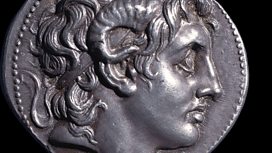Silver plate showing Shapur II
The history of the world told through objects. This week Neil MacGregor is exploring faith and the emergence of images to express the divine. Today, an image of faith from Iran.
Throughout this week Neil MacGregor is describing how people across the globe around 1700 years ago found new images to express their religious beliefs. Today's object is a dramatic visualisation of power and faith in 4th Century Iran. It is a silver plate that shows King Shapur II out hunting deer. Neil describes how this apparently secular image reveals the beliefs of the day, when the king was seen as the agent of god and the upholder of the state religion - Zoroastrianism. How might we read this hunting scene as a religious image? And why did the belief system of such a powerful dynasty fail to become a dominant world religion? With contributions from the historian Tom Holland and the Iranian art historian Guitty Azarpay.
Producer: Anthony Denselow
Last on
![]()
More programmes from A History of the World in 100 Objects related to leaders & government
About this object
Location: Iran
Culture: Ancient Middle East
Period: 4th century AD
Material: Silver
Ěý
This plate depicts a Sasanian king, probably Shapur II, leaping onto a stag and stabbing it in its neck. Sasanian kings were frequently portrayed as hunter-warriors, protecting their subjects from wild animals that ate their livestock or crops. Shapur II fought two long wars against the Roman Empire and, after killing the Roman emperor Julian, forced them to make peace with him. Shapur II also rigorously promoted Zoroastrianism, during the same period Christianity became the official religion of the Roman Empire.
Who were the Sasanians?
The Sasanians came from Iran and ruled a large empire from Iraq to Afghanistan from AD 224 to 622. They were the first Iranian dynasty to promote Zoroastrianism as the state religion. Zoroastrianism is the earliest religion to be based on a set of scriptures ? the teachings of the Prophet Zoroaster or Zarathustra. The conflict between man and animal on this plate may reflect the struggle between good and evil that lies at the heart of Zoroastrianism.
Did you know?
- A previous Sasanian king is said to have killed Roman emperor Valerian in AD 260 by forcing him to swallow molten gold.
The king of kings
By Tom Holland, author and historian
Ěý
The Sassanian Empire is the second great ancient empire that is founded in the land of Iran. Originally we have the empire of Cyrus and Darius who fought the Greeks and was overthrown by Alexander. Then in 224 AD the Persian king, Ardashir, overthrows his Parthian overlords, and establishes a Persian Empire right on the borders of the Roman Empire.
What it says to me is a magnificent expression of the Persian ideal of kingship – which absolutely underlies Persian civilisation throughout the entire ancient period. This is the image of what the Persians call Shah n Shah – king of kings. He rules because he is strong, because he is mighty, because he is powerful. And this was absolutely fundamental to the way the Persians saw the functioning of the world.
There’s this wonderful detail – when the Persian king rode into battle no one was allowed to have a taller horse, and he would have grooms standing around to make sure his horse didn’t even urinate, because that would obviously diminish the royal aura. What you have here is a horse that is in no danger of urinating because it is an absolutely ideal model of what a horse should be, just as the king is an absolute ideal model of what a man should be.
Meet the Sasanians
By Vesta Sarkhosh Curtis, curator, British Museum
Ěý
The Sasanians, who originated from Fars in southern Iran and came to power in AD 224, ruled over an empire stretching from Mesopotamia (modern Iraq) to Afghanistan.
For over 400 years they were the main opponents of Rome and often fought for supremacy in various regions, in particular Armenia, until they were overthrown by the Arabs in 651.
Religion was important under the Sasanians and kings were keen to emphasise their religious affiliation wherever possible. They described themselves in their inscriptions as “The Mazda-worshipping … King of Kings of Iranians and non-Iranians, whose origin is of the gods”.
Mazda (orAhura Mazda), also known as Ohrmazd or Hormuz, is the Wise Lord and Creator of All in Zoroastrianism. This ancient Iranian religion is named after the Prophet Zarathushtra, known in Greek as Zoroaster. To this day Zoroastrianism is practised in Iran as well as in India and also other parts of the world. In India Zoroastrians are known as Parsees.
Under Shapur II (AD 309-379) Zoroastrianism became the state religion of Iran and remained so until Islam was gradually adopted after AD 651.
The Sasanians followed an earlier Near Eastern tradition and often depicted the king in symbolic hunting scenes, in which he attacks and kills a deer, a lion, or a boar. Such scenes emphasised the divine and earthly powers of the king, who in the Zoroastrian tradition was chosen by God.
Transcript
Broadcasts
- Wed 2 Jun 2010 09:45±«Óătv Radio 4 FM
- Wed 2 Jun 2010 19:45±«Óătv Radio 4
- Thu 3 Jun 2010 00:30±«Óătv Radio 4
- Wed 10 Mar 2021 13:45±«Óătv Radio 4
Featured in...
![]()
Leaders and Government—A History of the World in 100 Objects
More programmes from A History of the World in 100 Objects related to leaders & government
Podcast
-
![]()
A History of the World in 100 Objects
Director of the British Museum, Neil MacGregor, retells humanity's history through objects





